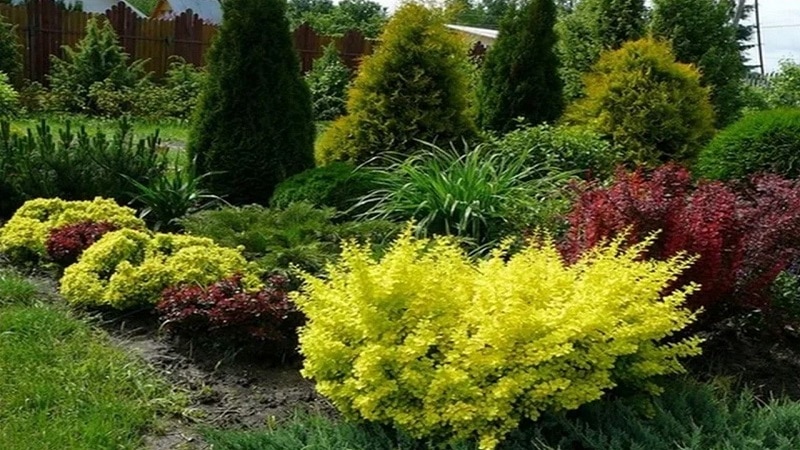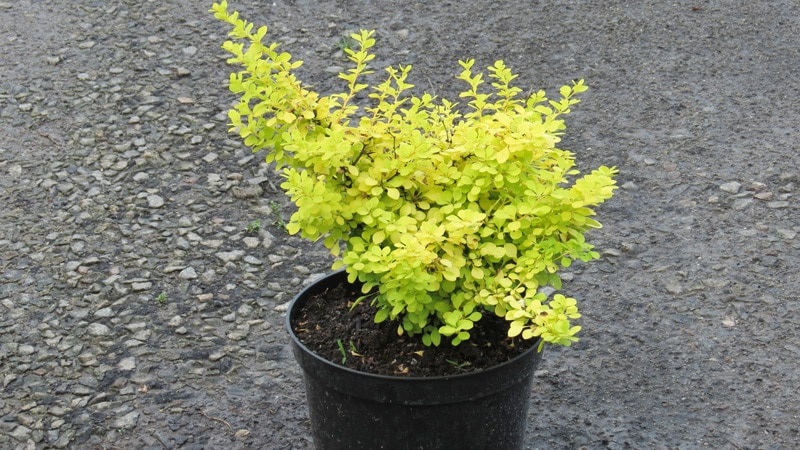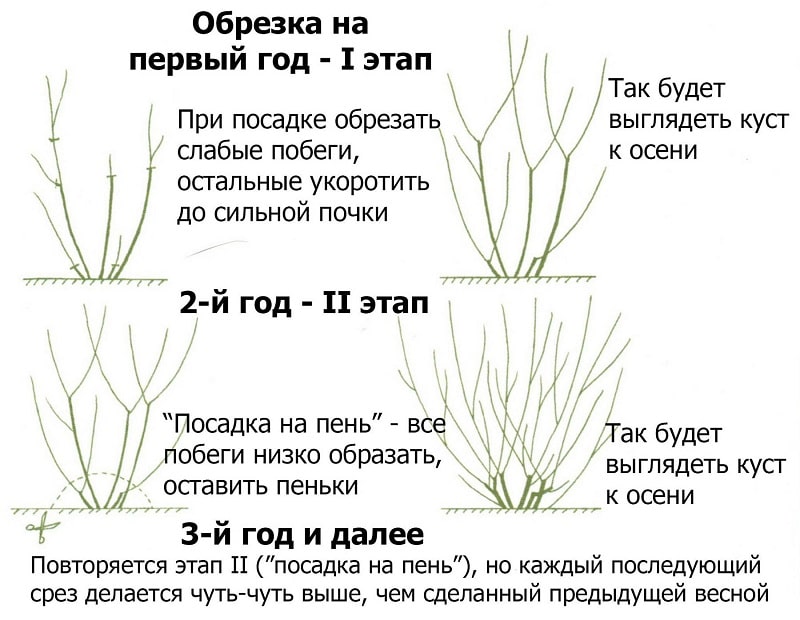Barberry Thunberg Aurea - description and application in landscape design
Barberry Thunberg Aurea looks great in any landscape composition, decorates any type of terrain, adapts to different types of soil and is undemanding to air quality. The shrub is popularly known as Aurelia barberry.
Barberry Aurea - a brief history of selection
Barberry Aurea is an ornamental shrub native to China and Japan. In these countries, the plant is widespread and grows mainly in the mountains. Climatic conditions have hardened barberry: the plant is resistant to cold, wind and drought.
In Russia, the bush is grown in the south and north. Gardeners pay attention primarily to attractive appearance, immunity to viruses and bacteria.

Description, features
Barberry Thunberg Aurea is used for landscaping garden plots. The bushes look impressive thanks to the original flowering. If you plant Aurea in a sunny place, the leaves will delight you with a magnificent yellow-lemon color.
Description of Barberry Aurea:
- bright leaf color when planted in a sunny area;
- bush height - 80 cm;
- compact size;
- crown width - up to 1.5 m;
- moderate growth vigor;
- in autumn the leaves turn orange;
- young shoots are covered with thorns in the color of the leaves;
- the flowering period begins in March and fades by summer;
- rich yellow inflorescences;
- scarlet fruits;
- all-season decorative effect thanks to berries.
The fruits of the Thunberg barberry are food for birds, but not for people.Birds enjoy feasting on scarlet berries, despite the bitter taste.
Compared to other varieties of barberry, this one is distinguished by its hardiness and can withstand changing weather conditions, deficiency and excess of moisture, drafts, and dirty air. Experienced gardeners do not recommend planting the shrub in the shade, otherwise it will lose its decorative effect: the leaves will be dark and faded.
Advantages of the variety:
- the shape of the bush, compact size, bright leaves, neat crown - all this allows you to use barberry to improve the local area;
- looks great as a single plant;
- does not conflict with other shrubs in case of group planting;
- has a strong root system;
- has strong immunity;
- easy to care for;
- unattractive to insects;
- recovers quickly after pruning.
Among the shortcomings are thorns. When working with bushes, be careful and protect your hands with gardening gloves.
There is a risk of shoots freezing, despite the high winter hardiness of the crop. The problem is solved by removing frozen branches.
Interesting things on the site:
The best winter-hardy varieties of climbing roses that bloom all summer
How to plant
Yellow barberry Aurea is easy to plant. First you need to determine the landing site and clear the area. Barberry loves the sun, so the planting area should be well lit. Bushes can also be planted in partial shade, but in too dark a place the plant loses its decorative effect.

Any soil is suitable; in this regard, Aurea barberry is unpretentious. The soil must be alkaline and well permeable to moisture. It is better to avoid planting in lowlands to avoid rotting of the root system.
It is not recommended to plant bushes in areas exposed to direct sunlight, as burns will appear on the leaves. It is for this reason that an area in partial shade is an ideal place for growing barberry.
Neighbors can be different representatives. To form a hedge, the bushes are planted at intervals of 4-5 seedlings per 1 m. The bushes are removed from the containers along with a lump of earth and planted in prepared holes. The procedure is performed in the spring after the snow melts or in the fall after the leaves fall.
Procedure for planting barberry:
- The soil on the site is loosened and the acidity is checked. The optimal pH is 6-7.5.
- Clay soil is lightened with sand, compost, and turf in equal proportions.
- To reduce acidity, add ash and lime to the soil at the rate of 200-300 g per plant.
- 3-year-old bushes are planted in a permanent place to a depth of 500 cm.
- Sand, humus, and turf are placed at the bottom of the hole and a drainage layer is formed.
- The prepared seedling is placed in a hole and covered with soil.
- The soil is compacted, watered and mulched with hay or sawdust.
How to care
The list of care procedures includes watering, fertilizing, pruning, preparing for winter and disease prevention.
Watering and fertilizing
After planting, Thunberg Aurea barberry is watered generously. Mulch retains moisture and reduces the frequency of watering. In the future, the gardener is only obliged to monitor the condition of the soil and respond in a timely manner, especially in dry weather. If the summer turns out to be rainy, barberry is watered once every 7 days. A bucket of water is poured under each bush.
A year after planting, barberry is fed with nitrogen. 25 g of urea are dissolved in 10 liters of water and poured under the root. The procedure is performed once every 3 years.
After watering, the soil is loosened superficially and the area is mulched if necessary.
Trimming
Shrubs are trimmed 3 years after planting. The procedure is best carried out in the spring. Undeveloped shoots, dry and frozen stems are removed. Sanitary pruning is performed as necessary.
To form a neat crown, decorative pruning is carried out twice a year - in June and August.
The photo below shows the procedure for pruning barberry.

Preparing for winter
Barberry Aurea overwinters without loss, but in the northern regions the bushes are insulated with agrofibre or spruce branches. A shelter from scrap materials is formed with the arrival of frost. Single bushes are wrapped in burlap and tarpaulin and tied with rope.
Diseases, their treatment and prevention
Barberry Thunberg Aurea has a strong immune system, thanks to which the plant rarely suffers from fungal diseases and is not subject to insect attacks. However, the condition of the bushes must be monitored. This makes it possible to identify the disease at an early stage and gives a greater chance of salvation.
The most common diseases of barberry:
- powdery mildew;
- spotting;
- rust on leaves.
The bright leaves are attacked by aphids and sawflies, and the flower moth feasts on the fruits.
Powdery mildew appears as a whitish coating on the foliage. Infected areas are pruned, the bushes are sprayed with fungicides (Fundazol, HOM, Skor). The same products are used to prevent powdery mildew.
Pests are controlled with insecticides (Aktellik, Fufanon, Kinmiks, Karbofos, Iskra). Folk remedies are ineffective.

Reproduction methods
Barberry Thunberg Aurea is propagated by seeds and cuttings, which are sold in garden stores.Autumn sowing is most effective; seeds produce a high percentage of seedlings.
Before sowing, seeds collected by hand are stratified:
- The fruits are dried and the seeds are extracted.
- The grains are washed and kept in a weak solution of potassium permanganate.
- Then they are sown in loosened and moist soil to a depth of 1 cm.
If the gardener still plans spring planting, the seeds need to be stratified for 3 months.
Barberry can be propagated by dividing the bush. To do this, an adult plant is dug up, separated with pruning shears and transplanted to a new location. This method is rarely used.
The most common is cuttings: young shoots with two nodes and internodes are cut into cuttings and rooted in pots filled with sand and peat in equal proportions. Planting to a permanent place is carried out after 1-2 years.
Read also:
The use of Thunberg barberry in landscape design
Barberry Aurea is often used to create landscape compositions. Yellow leaves attract the eye and make the shrub the center of the ensemble.
Aurea harmonizes with other varieties of barberry and various types of plants. The shrub is suitable for decorating front doors, rock gardens (rock gardens), artificial ponds, walls, paths, and fences. Regular trimming keeps the bushes looking neat.
Conclusion
Barberry Aurea is popular among gardeners and landscape designers. Yellow leaves and scarlet berries attract attention and combine well with other plants. The shrub is easy to care for and grows on any type of soil, as long as the soil is alkaline.
The plant loves the sun, so the best place for planting is a illuminated area or partial shade. In too dark a place the leaves will be faded. Plant care involves regular watering and fertilizing with nitrogen after planting, pruning, and prevention of fungal diseases.